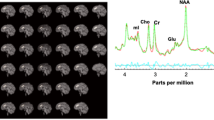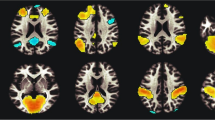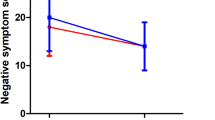Abstract
Reduced monoamine oxidase activity has been proposed as a marker for vulnerability to schizophrenia. Reduced monamine oxidase activity has also been shown to occur in cigarette smokers. This study compared monamine oxidase activity level in a matched group of patients with schizophrenia who smoked with a group who did not. Lower levels of monoamine oxidase activity were found in the smokers and this is the likely explanation for the low levels hypothesized as a marker for schizophrenia.
Similar content being viewed by others
Main
Reduced monoamine oxidase activity (MAO) was reported in 1972 (Murphy and Wyatt 1972) in the blood platelets of schizophrenic patients and they later suggested that reduced MAO activity might be a genetic marker for vulnerability to schizophrenia (Wyatt et al. 1973). Despite a review of twenty-six studies convincingly demonstrating a reduction in MAO activity in platelets of chronic schizophrenic patients (Wyatt et al. 1979), the finding of reduced MAO activity has remained controversial (Fleissner et al. 1987). Similarly, the explanation for the reduced MAO activity has remained uncertain (Marcolin and Davis, 1992). Investigations into this question have not reported smoking rates of the subjects. Recent studies have demonstrated that smoking is associated with reduced monoamine oxidase A and B activity (Oreland et al. 1981; Berlin et al. 1995; Fowler et al. 1996a and 1996b, Mendez-Alvarez et al. 1997). Since up to 80% of individuals with chronic schizophrenia smoke cigarettes (de Leon et al. 1995) smoking might be both the confounding variable confusing the data, as well as the explanation for the reduced MAO activity. The reason for the reduced MAO activity in schizophrenics might well be the higher rate of smoking in these patients. As part of a series of studies in smoking and schizophrenia, a comparison was made of monamine oxidase B in the platelets of smoking and non-smoking schizophrenics.
SUBJECTS
The subjects were 14 male Hispanic outpatients at LAC/USC Psychiatric Outpatient Clinic with a DSM-IV diagnosis of schizophrenia or schizoaffective disorder. Seven patients smoked at least one pack of cigarettes per day, the other seven did not smoke. The subjects were matched as closely as possible for age, with a mean age of 39.3 in the smokers and 29.8 in the non-smokers. Their ages ranged from 20 to 66 years. The control was a 37-year-old male non-smoking psychiatric Fellow.
METHODS
Morning blood samples were taken following an overnight “fast” from smoking for approximately twelve hours. Platelet MAO activity was assayed according to the following procedure. First, 20 cc of whole blood was drawn from the antecubital vein into a plastic syringe and transferred to a plastic tube containing 1 cc of 3.8% sodium citrate as an anticoagulant. The specimen was centrifuged at 600 rpm for 15 min and at 20,000 g for 5 min to yield a platelet pellet. The pellet was washed with 2 cc of 0.9% sodium chloride and spun again at 20,000 g for 5 min. The platelet pellet was stored at −70°C, until assay. The pellet was resuspended and sonicated in 1 cc of 0.05 M phosphate buffer, (pH 7.4). About 300 ug of the resulting protein was incubated with 14C-phenylethylamine with a final concentration of 10 uM. After a 20-min incubation at 37°C, the reaction was terminated by the addition of 0.1 ml of 6 N HCl. The reaction product was extracted with 6 ml of toluene to yield MAO-B, and the remaining substrate was deleted. Each tube was capped and shaken for 30 sec. The tubes were centrifuged at 200 rpm for 10 min to separate the two phases. Four milliliters of the organic layer were withdrawn and mixed with 5 ml of scintillation fluid (National Diagnostics). The radioactivity of the reaction product was determined by liquid scintillation spectrometry (Chen et al. 1994).
RESULTS
Results are shown in Table 1. There is very little overlap between the levels in smokers and non-smokers, and even this small sample size reveals a highly significant reduction in MAO-B activity in the smokers (p = .004). Because MAO is reduced in the elderly, age must be controlled for. Figure 1 strongly suggests that controlling for age does not change the results.
DISCUSSION
The present study has several weaknesses. First this study, like all previous studies, made no attempt to control for the effects of passive smoking on monoamine oxidase levels. Second, the smokers in this study were older than the non-smokers, and our data do not absolutely exclude the possibility that some or all of the observed MAO differences could be due to the older age of the smokers. Notable here is the result that none of the smokers have a higher MAO activity level than the oldest non-smoker. Finally, our conclusions could be strengthened by more accurate measures of individual smoke exposure, i.e., plasma nicotine or cotinine levels, or a nicotine-cotinine ratio derived from a 24 hour urine collection.
Overall, the results of this study are not surprising, given the evidence that smoking reduces monoamine oxidase activity. It was, however, important to demonstrate this in patients with schizophrenia and attempt to explain the previous findings. The proposed genetic vulnerability was related to a study in identical twins discordant for schizophrenia which showed reduced MAO activity in both co-twins, suggesting that the reduction was not secondary to schizophrenia but might represent a marker for vulnerability to schizophrenia (Wyatt et al. 1973). As this study did not control for smoking, it may well be that the reduced MAO activity was due solely to either active (or passive) exposure to smoke, and not due to any genetic predisposition to schizophrenia per se. However, there may still remain a relationship between MAO activity and schizophrenia, albeit secondary to the tendency to smoke (de Leon 1996). Recent work has shown many ways that nicotine alters neuronal functioning, and explanations of how smoking could benefit schizophrenics (and other psychiatric populations) have been suggested (Glassman 1993; Ziedonis et al. 1994; de Leon 1996; Leonard et al. 1996).
Interestingly, Berlin et al. (1997) reached a similar conclusion about major depression, a disorder which is also associated with reduced MAO activity. They concluded that the monoamine oxidase inhibition associated with depression is probably the result of smoking per se, rather than any type of biological marker for depression.
CONCLUSION
The low levels of MAO activity reported in schizophrenia are most likely related to cigarette smoke.
References
Berlin I, Saıuml;d S, Spreux-Varoquaux O, Olivares R, Launay J-M, Puech AJ . (1995): Monoamine oxidase A and B activities in heavy smokers. Biol Psychiatry 38: 756–761
Berlin I, Spreux-Varoquaux O, Saıuml;d S, Launay J-M . (1997): Effects of past history of major depression on smoking characteristics, monoamine oxidase-A and -B activities and withdrawal symptoms in dependent smokers. Drug and Alcohol Dependence 45: 31–37
Chen K, Wu H-F, Shih JC . (1994): Cloning of a novel monamine oxidase (MAO) c DNA from trout liver. Mol Pharm 46: 1226–1233
de Leon J, Dadvand M, Canuso C, White AO, Stanilla JK, Simpson GM . (1995): Schizophrenia and smoking: An epidemiologic survey in a state hospital. Am J Psychiatry 152: 453–455
de Leon J . (1996): Smoking and vulnerability for schizophrenia. Schizophrenia Bulletin 22: 3: 405–409
Fleissner A, Seifert R, Schneider K, Eckert W, Fuisting B . (1987): Platelet monoamine oxidase activity and schizophrenia—A myth that refuses to die?. Eur Arch Psychiatr Neurol Sci 237: 8–15
Fowler JS, Volkow ND, Wang G-J, Pappas N, Logan J, MacGregor R, Alexoff D, Shea C, Schlyer D, Wolf AP, Warner D, Zezulkova I, Cilento R . (1996): Inhibition of monamine oxidase B in the brains of smokers. Nature 379: 733–736a
Fowler JS, Volkow ND, Wang G-J, Pappas N, Logan J, Shea C, Alexoff D, MacGregor RR, Schlyer DJ, Zezulkova I, Wolf AP . (1996): Brain monoamine oxidase A inhibition in cigarette smokers. Proc Natl Acad Sci 93: 14065–14069b
Glassman AH . (1993): Cigarette smoking: implications for psychiatric illness. Am J Psychiatry 150: 546–553
Leonard S, Adams C, Breese CR, Adler LE, Bickford P, Byerley W, Coon H, Griffith JM, Miller C, Myles-Worsley M, Nagamoto HT, Rollins Y, Stevens KE, Waldo M, Freedman R . (1996): Nicotinic receptor function in schizophrenia. Schizophrenia Bulletin 22: 3: 431–445
Marcolin MA, Davis JM . (1992): Platelet monoamine oxidase activity in schizophrenia: A meta-analysis. Schizophrenia Research 7: 249–267
Mendez-Alvarez E, Soto-Otero R, Sànchez-Sellero I, Lamas M . (1997): Inhibition of brain monoamine oxidase by adducts of 1,2,3,4-tetrahydroisoquinoline with components of cigarette smoke. Life Sciences 60: 19: 1719–1727
Murphy DL, Wyatt RJ . (1972): Reduced monoamide oxidase activity in blood platelets from schizophrenic patients. Nature 238: 225
Oreland L, Fowler CJ, Schalling D . (1981): Low platelet monoamine oxidase activity in cigarette smokers. Life Science 29: 2511–2518
Wyatt RJ, Murphy D, Belmaker R, Cohen S, Donnelly CH, Pollin W . (1973): Reduced Monoamine Oxidase Activity in Platelets: A Possible Genetic Marker for Vulnerability to Schizophrenia. Science 179: 916–918
Wyatt RJ, Potkin SG, Murphy DL . (1979): Platelet monoamine oxidase activity in schizophrenia: A review of the data. Am J Psychiatry 136: 4A: 377–385
Ziedonis DM, Kosten TR, Glazer WM, Frances RJ . (1994): Nicotine dependence and schizophrenia. Hosp and Comm Psychiatry 45: 204–206
Author information
Authors and Affiliations
Rights and permissions
About this article
Cite this article
Simpson, G., Shih, J., Chen, K. et al. Schizophrenia, Monoamine Oxidase Activity, and Cigarette Smoking. Neuropsychopharmacol 20, 392–394 (1999). https://doi.org/10.1016/S0893-133X(98)00119-5
Received:
Revised:
Accepted:
Issue Date:
DOI: https://doi.org/10.1016/S0893-133X(98)00119-5
Keywords
This article is cited by
-
Translational Neuroimaging: Positron Emission Tomography Studies of Monoamine Oxidase
Molecular Imaging and Biology (2005)
-
Association study of an SNP combination pattern in the dopaminergic pathway in paranoid schizophrenia: a novel strategy for complex disorders
Molecular Psychiatry (2004)




